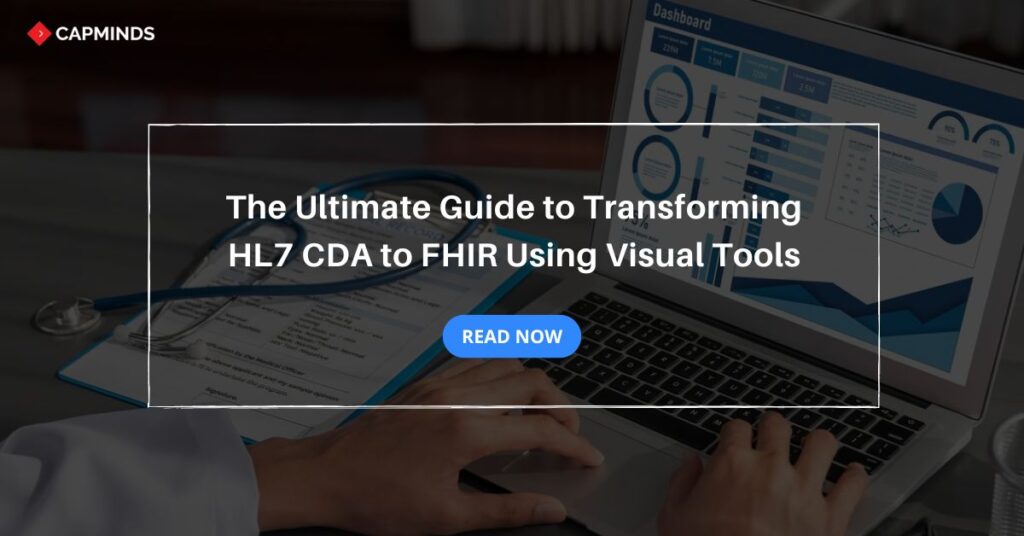The Ultimate Guide to Transforming HL7 CDA to FHIR Using Visual Tools
Healthcare systems rely on effective health data exchange. However, the transformation from an older data format like HL7 CDA to a newer and modern format like FHIR involves many challenges. The conversion of these data formats provides accurate and real-time data sharing across platforms while also resolving structural variances, confusing terminology, and the danger of data loss.
In this blog, we discussed the problems of CDA-to-FHIR conversion, the role of visual aids in simplifying the process, and a step-by-step strategy for guaranteeing a successful transformation.
What Are HL7 CDA and FHIR?
Healthcare systems generate and store massive amounts of data daily. However, the data structure and how it is shared differ. There are two critical data standards in health data interoperability which are HL7 Clinical Document Architecture and Fast Healthcare Interoperability Resources.
HL7 CDA
- HL7 CDA format was initially introduced in the early 2000s.
- It is an XML-based document-centric format designed to exchange healthcare documents including discharge summaries, lab reports, or imaging studies.
- The CDA’s format strength lies in its detailed and standardized approach to presenting clinical information.
FHIR
- FHIR was introduced in 2014 by HL7.
- It is a more flexible and web-friendly framework that uses modern technologies like JSON and REST.
- FHIR provides a resource-based model and represents specific aspects of healthcare data, like patient demographics, clinical observations, or medication records.
This modularity allows FHIR to enable seamless data exchange and integration across systems with fewer redundancies and greater ease of analysis.
The Challenges of Converting CDA to FHIR
The conversion of HL7 CDA Documents to FHIR resources has many challenges. Here are the some of challenges:
1. Different data structures
The CDA and FHIR formats differ fundamentally in their design. CDA is document-oriented presenting clinical data as a cohesive whole whereas FHIR uses a module and resource-based structure. Data conversion between these two formats requires detailed mapping of data elements to ensure no data loss.
For instance, a single CDA document might include complete patient data while the FHIR format divides the same data into resources like “Patient”, “Observation”, and “Encounter”. Aligning these structures demands careful analysis and transformation rules.
2. Complex healthcare terms
Both CDA and FHIR rely on standardized terminologies to represent clinical concepts, but these terminologies often differ. Mapping equivalent terms between the two standards is critical to maintain semantic accuracy.
Without precise mapping between the structures, the health data can be lost. Additionally, differences in how vendors and healthcare providers implement these standards can introduce inconsistencies which further complicates the process.
3. Risk of losing important information
CDA documents often include detailed narrative sections and contextual data that provide essential clinical insights. FHIR’s concise resource-based structure, while efficient, may not always capture these narratives fully. During the conversion process, there is a risk of omitting or oversimplifying critical details, which could affect patient care or data analysis.
To mitigate this risk, robust validation mechanisms and transformation techniques are essential to ensure no loss of valuable information.
Related: 5 Challenges Associated with HL7 FHIR and How CapMinds Helps to Solve
How Visual Tools Make the Conversion Process Easier
Manual transformation of CDA Documents into FHIR resources can be daunting because of the technical hurdles and as well as time-consuming.
Fortunately, modern visual tools simplify this process, making it more accessible to domain experts with minimal coding knowledge. Here’s how visual tools ease the conversion process:
1. Drag-and-Drop Tool
- Visual tools offer a simple and user-friendly interface where users can map HL7 CDA Documents with FHIR resources using the drag-and-drop tool.
- So, the users don’t have to write extensive lines of code.
- This will allow the domain experts to focus on the content rather than technical details.
2. Reusable Rules and Components
- Visual tools can create reusable transformation rules.
- If you have mapped a CDA Patient identifier to a FHIR Resource, you can reuse that rule across multiple transformations
- This will help to reduce the need for development time.
3. Automated Error Detection
- A visual tool often has a built-in validation feature that can automatically check for errors or inconsistencies in mapping.
- This feature ensures that the transformed data aligns with FHIR standards and maintains semantic accuracy.
Related: HL7 FHIR Bulk Data Access: Setting a New Standard for UDS Reporting
How to Transform HL7 CDA to FHIR Using Visual Tools (Step-By-Step Guide)
The conversion of the HL7 CDA document into the FHIR resource might sound technical. But with the help of visual tools, this complex process can be broken down into simple steps. Here are the steps:
Step 1: Set Up the Tool
The first step is to configure the visual tool for your transformation task. This typically involves:
- Importing the CDA templates that represent your existing data.
- Loading the FHIR resource definitions that outline the target structure.
- Defining your transformation goals, such as converting patient demographics or clinical observations.
Tools like TermX allow you to organize these inputs into a centralized workspace, providing a clear overview of your data and transformation requirements.
Step 2: Create Transformation Rules
Once your data and goals are set, it’s time to create the actual mappings:
- Use the drag-and-drop editor to connect elements from CDA to FHIR. For example, map the “Administrative Gender” field in CDA to the corresponding “Gender” resource in FHIR.
- Leverage reusable components for common mappings, such as converting CDA codes to FHIR codeable concepts or translating patient identifiers.
This step ensures that all elements are correctly aligned, preserving the data’s semantic meaning.
Step 3: Validate Your Work
Validation is a crucial step to ensure accuracy and compliance with FHIR standards:
- Run automated tests provided by the tool to check for errors or inconsistencies in the mappings.
- Use visualization features to inspect how the transformed data will appear in FHIR format, ensuring it meets your expectations.
- If any issues arise, refine your transformation rules and rerun the validation process.
Validation not only ensures the quality of your transformations but also builds confidence in the final output.
Step 4: Deploy the Transformation
Once your transformations are validated, you’re ready to deploy them in a real-world environment:
- Export the transformation components and integrate them into your data workflows.
- For instance, you can set up a system where CDA documents are dynamically converted into FHIR bundles in real-time.
CapMinds HL7 FHIR Service for Healthcare Practice
CapMinds offers the best all-in-one health interoperability solution for healthcare practices. Our HL7 FHIR service will understand your clinical needs and requirements to cater to our solution.
We have years of experience in this field faced many challenges and tackled them with ease. Why can CapMinds be your Go-to Interoperability Solution?
- We are experienced professionals with years of experience in the field.
- Our technical team is an expert who will analyze your healthcare practice thoroughly to tailor the Interoperability solution.
- We prioritize safety, security, encryption, and authentication to protect your healthcare practice patient’s data.
- Our comprehensive solution ensures seamless interoperability adhering to industry standards, and using standard protocols.
- We offer comprehensive training sessions to healthcare staff.
- Our affordable health interoperability solution benefits healthcare practice at all levels.
If you are searching for the best interoperability service for your practice, CapMinds is your choice. We can assist you by navigating all potential challenges and ensuring seamless health data exchange.
Reach out to CapMinds Health Data Exchange Solutions for your Healthcare Practice.




